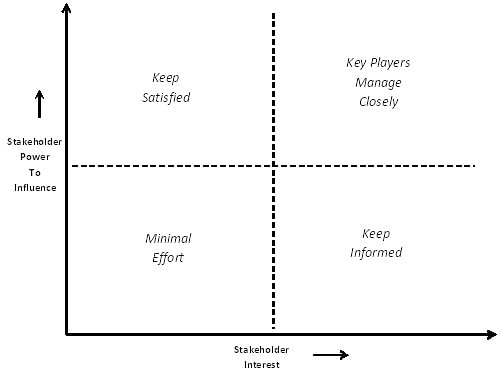PMI® has addressed the voice of thousands of Project Managers across the globe and has added ‘Stakeholder Management’ as a new Knowledge Area in the Fifth Edition of PMBOK Guide. The importance of Stakeholder Engagement cannot be stressed enough and it truly deserves its rightful place as an independent Knowledge Area in Project Management.
The guide includes a process on ‘Manage Stakeholder Engagement’. It also advises the Project Managers to move towards a model where Stakeholders engagement levels are either ‘Supportive’ or ‘Leading’. This article attempts to provide some guidelines and pointers to achieving the desired levels of Stakeholder Engagement.
Want to become a project management pro? Our project management certification course is all you need to become one. Explore more about the program now.
As a first step, Project Managers identify the Stakeholders and Map them to an Influence – Interest grid. The same is shown as under.

Once the Stakeholder Identification and mapping are done, the Project Managers should then decide on the methods of engagement required for every Stakeholder. Project Managers should not apply a single strategy for all stakeholders. Depending on the mapping, as shown above, each group of Stakeholders will be taken through different methods of engagement as elaborated below.
1. Interest-Low and Influence-Low
Stakeholders falling into this category require limited monitoring and Management effort. The Project Manager should provide them with Balanced and Objective Information. This information can be provided via briefing sessions, leaflets, magazines, corporate publications, etc. Generally, the Push method of communication is utilized. One-Way communication is adopted.
2. Interest-High and Influence-Low
The Project Manager should keep Stakeholders falling into this category informed about the happenings in the Project. The Project Manager may want to solicit feedback on certain Project decisions. The Stakeholders need to be educated about the Project and two-way communication is encouraged to engage with the Stakeholders. Focus Groups, workshops, surveys, public meetings, web forums, etc., are some of the techniques to be utilized.
3. Interest-Low and Influence-High
This is the third quadrant of the above grid and the Project Manager has to ensure that the Stakeholders are kept satisfied throughout the Project. They should be kept in the loop for all Project decisions. They wield a good amount of Power and carry the potential to make or break the Project. Their concerns and needs should be identified and addressed throughout the Project. The Project Manager should understand that the Stakeholders in this quadrant may be providing conditional support and may withdraw this support if the said conditions are not met. Being cognizant of this fact can help Project Managers employ the right engagement models for the Stakeholders. Two-Way open communication must be established. The Project Manager must solicit feedback on Project Decisions and alternatives. In short, Project Managers should involve than and/or consult them on all major Project decisions.
4. Interest-High and Influence-High
Most of the focus of the Project Managers would be towards effective engagement of Stakeholders falling into this quadrant. They need to be monitored very closely. The methods employed have to collaborative and/or empowering. All Project decisions should be arrived at through a partnership approach. It is possible that some of the Stakeholders in this category wield the final decision-making authority. The Project Manager should facilitate forums for deliberations and decision making. These stakeholders have the biggest impact on Project success.
| Are you skilled enough for the role of a project manager? Well take up this free PMP Exam Practice Test and assess your skills! |
Conclusion
It is clear that there is no single rule for Stakeholder engagement which applies to all Stakeholders. The Project Managers have to be aligned with the Stakeholders through the Project and change their strategies depending on the Project Requirements. It is important to note that the levels of Stakeholders’ engagement should move towards being ‘Supportive’ or ‘Leading’ for Stakeholders in the last quadrant. These engagement levels have to be continuously monitored and adjusted until Project closure.
PMP® and PMI® are registered trademarks of the Project Management Institute, Inc.


